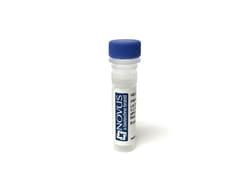DPPIV/CD26 Antibody (DPP4/910) - Azide and BSA Free, Novus Biologicals™
Mouse Monoclonal Antibody
Manufacturer: Fischer Scientific
The price for this product is unavailable. Please request a quote
Antigen
DPPIV/CD26
Concentration
1.0 mg/mL
Applications
Flow Cytometry, Immunohistochemistry (Frozen), Immunofluorescence, CyTOF
Conjugate
Unconjugated
Host Species
Mouse
Research Discipline
Adaptive Immunity, Cellular Markers, GPCR, Immunology
Formulation
PBS with No Preservative
Gene ID (Entrez)
1803
Immunogen
Recombinant human DPP4 protein
Primary or Secondary
Primary
Content And Storage
Store at 4C short term. Aliquot and store at -20C long term. Avoid freeze-thaw cycles.
Molecular Weight of Antigen
110 kDa
Clone
DPP4/910
Dilution
Flow Cytometry : 0.5 - 1 ug/million cells in 0.1 ml, Immunohistochemistry-Frozen : 0.5 - 1.0 ug/ml, Immunofluorescence : 0.5 - 1.0 ug/ml, CyTOF-ready
Classification
Monoclonal
Form
Purified
Regulatory Status
RUO
Target Species
Human, Rat, Porcine (Negative), Sheep (Negative)
Gene Alias
ADABP, ADCP-2, ADCP2DPP IV, Adenosine deaminase complexing protein 2TP103, CD26 antigen, CD26T-cell activation antigen CD26, dipeptidyl peptidase 4, Dipeptidyl peptidase IV, dipeptidylpeptidase 4, dipeptidyl-peptidase 4, dipeptidylpeptidase IV (CD26, adenosine deaminase complexing protein 2), DPPIV, EC 3.4.14.5
Gene Symbols
DPP4
Isotype
IgG2b κ
Purification Method
Protein A or G purified
Test Specificity
Recognizes a glycoprotein of 110kDa, identified as CD26. It is an atypical serine protease belonging to the prolyl oligopeptidase family. It is expressed on lymphocyte cells and is upregulated during T-cell activation. CD26 is also expressed on activated B cells and natural killer cells and abundantly on epithelia. CD26 is implicated in a variety of biological functions including T-cell activation, cell adhesion with extracellular matrix such as fibronectin or collagens, and in HIV infection.
Description
- DPPIV/CD26 Monoclonal specifically detects DPPIV/CD26 in Human, Rat, Porcine (Negative), Sheep (Negative) samples
- It is validated for Flow Cytometry, Immunohistochemistry, Immunocytochemistry/Immunofluorescence, Immunohistochemistry-Frozen, Flow (Cell Surface), Immunofluorescence, CyTOF-ready.


